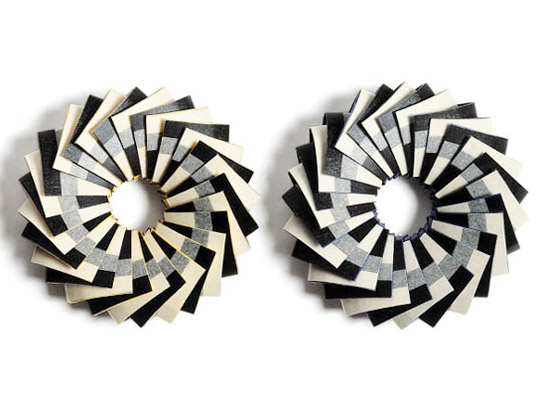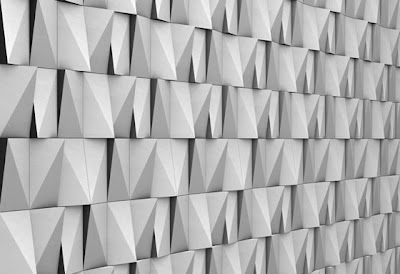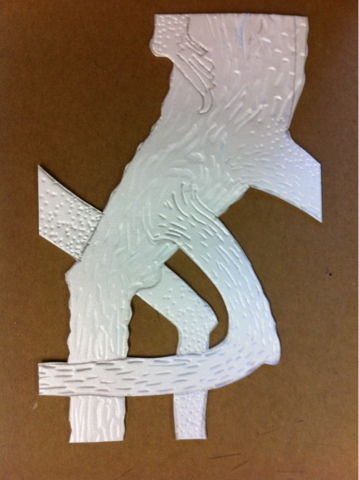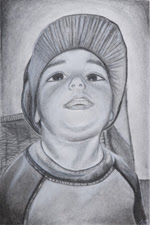Art.sy is a site devoted to exploring the world of art.
For you it is a wonderful source for examples of artists using materials to express their ideas!
See more at the link @ http://art.sy/
I used their "BROWSE" feature to look for assemblage, or mixed media artwork.....
More examples of mixed media art from that site.....
This work is by Jim Dine called At Kew Gardens, 2012
This is work by Ashley Bickerton, Orange Head 1. He used paint over a printed image and added objects, like shells...
Work by Gordon Cheung, Still Life with Tulips on Orange, 2011 . He used acrylic on top of newsprint fragments with an inkjet-printed image.
Monday, December 3, 2012
Wednesday, November 28, 2012
An artist using TEXTURE!!!
Vhils, AKA Alexandre Farto, is a Portuguese graffiti artist creating images on walls, bilboards and wood.
One dynamic characteristic of his work is his use of a cutting away of the surface to create the images....
See more here @ http://alexandrefarto.com/
and here @ http://www.youtube.com/watch?v=R2_tdw8lINE
Here are some examples of his work...
One dynamic characteristic of his work is his use of a cutting away of the surface to create the images....
See more here @ http://alexandrefarto.com/
and here @ http://www.youtube.com/watch?v=R2_tdw8lINE
Here are some examples of his work...
Wednesday, November 14, 2012
More Modular Ideas!!
Ronan and Erwan Bouroullec are designers working with modular structures. Much of their designs are functional objects for the home- furniture, room dividers, etc.....
Notice their influences from NATURE and their use of a CREATIVE PROCESS
See more of their work here @ http://www.bouroullec.com/
and more info here @ http://www.dezeen.com/2009/01/16/clouds-by-ronan-and-erwan-bouroullec/
And even here @ http://www.dezeen.com/2009/04/07/vegetal-growing-by-ronan-and-erwan-bouroullec/
Notice their influences from NATURE and their use of a CREATIVE PROCESS
See more of their work here @ http://www.bouroullec.com/
and more info here @ http://www.dezeen.com/2009/01/16/clouds-by-ronan-and-erwan-bouroullec/
And even here @ http://www.dezeen.com/2009/04/07/vegetal-growing-by-ronan-and-erwan-bouroullec/
Tuesday, November 13, 2012
Printed Jewelry!
Goncalo Campos makes this bracelet using a 3D printer!
What's the module? triangles!!!
See more of their work here @ http://www.goncalocampos.com/
What's the module? triangles!!!
See more of their work here @ http://www.goncalocampos.com/
Nel Linssen's Modular jewelry
Here are some more Modular Construction ideas.....
Look how the forms are attached (string) letting them CHANGE shape and size.....
Interesting use of TWISTED forms too!
See more here @ http://www.nellinssen.nl/index.html
See more about this one here @ http://www.nellinssen.nl/work_2006_movie.html
Look how the forms are attached (string) letting them CHANGE shape and size.....
Interesting use of TWISTED forms too!
See more here @ http://www.nellinssen.nl/index.html
See more about this one here @ http://www.nellinssen.nl/work_2006_movie.html
Thursday, November 8, 2012
MODULAR Sculpture
Here are some examples of structures created by assembling "modules" to create complex forms....
Our chief inspiration for modular construction is Erwin Hauer.... here are some images of his work and structures....
see more about him here @ http://www.erwinhauer.com/
ALSO,
Check out Richard Sweeney's work with paper modules...... @ http://www.richardsweeney.co.uk/paper.html
AND,
The wearable sculpture of Eunsuk Hur, see more here @ http://eunsukhur.com/#/nomadic_wonderland/recent_project:_about_normadic_wonderland/image_3
Our chief inspiration for modular construction is Erwin Hauer.... here are some images of his work and structures....
see more about him here @ http://www.erwinhauer.com/
ALSO,
Check out Richard Sweeney's work with paper modules...... @ http://www.richardsweeney.co.uk/paper.html
AND,
The wearable sculpture of Eunsuk Hur, see more here @ http://eunsukhur.com/#/nomadic_wonderland/recent_project:_about_normadic_wonderland/image_3
Thursday, October 25, 2012
Friday, September 7, 2012
START BLOGGING!
Let's create your blogs for use in the class.... here are directions
BLOGGING
*Remember, you are making a blog to use for the class.All postings and images used in your blog should be appropriate for use inschool AND should follow Academy standards for technology use.
1. Go to www.blogger.com and click on the orange button that says"create a blog".
2. Follow the prompts. You should be able to sign in using your Academy (or your own) emailaddress and a password. Write down the password- hang on to it!
When creating a display name doNOT use your first AND last name (you could use initials or first, last only),and whatever else it asks for. It might ask to send you a text message, thensend you a code, and you'll enter the code online. Now you have an account.
3. Name your blog...keep the web address something you'll remember andthe name something responsible.
4. Follow the prompt to choose a template you like the look of. Youcan always change it later if you want by clicking on the design tab.
5. Click the orange button that says start blogging and you will bebrought to the page where you write your posts...but first, let's adjust someof the settings...
6. Click on the settings tab up above.
· Then click on the formatting tab and make sureyou have the time set to the eastern time zone. Scroll down to the bottom andclick save.
· Then click on the posts and comments tab, set it up as shown here.... add other class members emails as registered users and enter your email address next to comment notificationemail. This way you'll be emailed when a post receives a comment.
Click save.
Click save.
7. Click on the design tab.
· On the right side click on add a gadget. A menuwill pop up. Scroll down to labels. Click on the blue plus sign and click save.
· Hint: This is also the tab where colors andfonts live if you want to change them (under template designer).
· Also, in gadgets, delete the “about me” gadget.
Do not put personal info on the blog!
8. Click on the view blog tab to see how itlooks. You can play with the look of the blog by clicking on the design tab.
9. In the top right corner you should see “newpost”. Click on that and begin writing in the space provided. When answeringquestions from the class blog, match the post title in your response title.
· Note: If you want to add a photo there is abutton to do in the toolbar above the post. It looks like a little photograph.
· Note: There IS spellcheck. It's located in thetoolbar. Use it!
· You have a choice when writing to save (forlater) or post.
10. If you want to go back and edit posts later on...you can click onnew post, then the edit posts tab. A menu of all your posts will appear and youcan click on the one you want to edit.
DON'T FORGET TO EMAIL Mr.Powers A LINK (the URL) TO YOUR BLOG!
DON'T FORGET TO EMAIL Mr.Powers A LINK (the URL) TO YOUR BLOG!
Sendme your email and the password for your site. I reserve the right to remove any inappropriatepostings from your site.
* Blogger is changing all thetime. It's possible that you won't be able to follow these directions exactly.
* Blogger is changing all thetime. It's possible that you won't be able to follow these directions exactly.
If you get stuck, check with Mr. Powers.
Tuesday, August 28, 2012
Jasper Johns and the "hatch marks"
Johns is known for his use of patterns, shapes and symbols in his artwork. He is often playing with the idea that artwork is about the illusion of depth and space on a flat surface..... he uses fragments of other artist's work, sometimes projecting and tracing, and builds on them.
Here are some examples of his use of pattens of lines....
See more about Johns here @ http://www.nytimes.com/2008/02/08/arts/design/08john.html
"Seeing a thing can sometimes trigger the mind
to make another thing"
Here are some examples of his use of pattens of lines....
See more about Johns here @ http://www.nytimes.com/2008/02/08/arts/design/08john.html
Edvard Munch's painting "Between the Clock and the Bed"
John's painting "Between the Clock and the Bed"
 |
| “Between the Clock and the Bed” (1982-83), encaustic on canvas |
"Dancers On A Plane" ,
Untitled (ULAE # 256), 1992
Color aquatint
43 1/2 x 52 9/16 in. / 110.5 x 133.5 cm.
Color aquatint
43 1/2 x 52 9/16 in. / 110.5 x 133.5 cm.
 | |
| the artist |
What Does Good Work Look Like?
Here are several samples of drawing work from the AP website.....
See more of the work here @ http://apcentral.collegeboard.com/apc/members/exam/exam_information/218374.html#
Look how the work recieving the BEST score has strong use of MATERIALS, COMPOSITION and a unifying IDEA or THEME.
Here is an example of work recieving a low score, or 3
Here is an example of work a score of 4
Here is an example of work a score of 5
Here is an example of work receiving the highest score of 6
See more of the work here @ http://apcentral.collegeboard.com/apc/members/exam/exam_information/218374.html#
Look how the work recieving the BEST score has strong use of MATERIALS, COMPOSITION and a unifying IDEA or THEME.
Here is an example of work recieving a low score, or 3
Here is an example of work a score of 4
Here is an example of work a score of 5
Here is an example of work receiving the highest score of 6
Subscribe to:
Comments (Atom)
























































